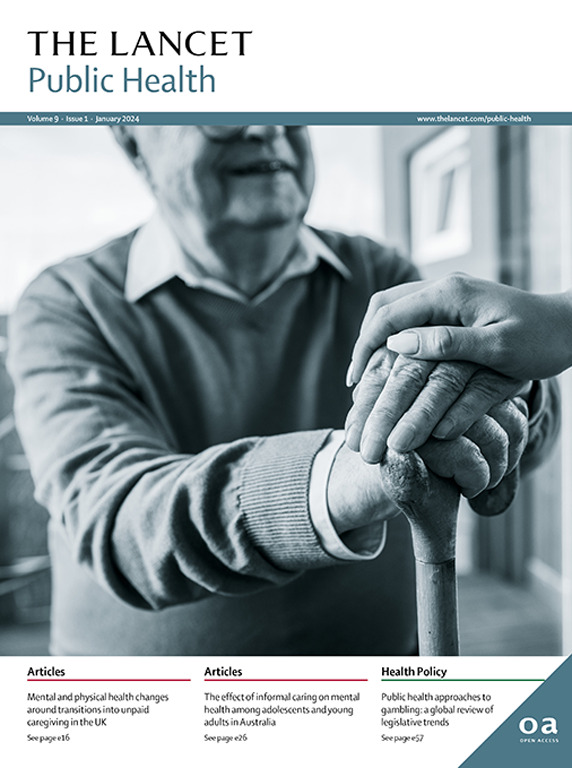1990-2021年日本三十年人口健康变化:2021年全球疾病负担研究的次国家分析
IF 25.4
1区 医学
Q1 PUBLIC, ENVIRONMENTAL & OCCUPATIONAL HEALTH
引用次数: 0
摘要
鉴于日本人口结构迅速老龄化,对其国家和地方卫生进展进行全面和长期评估对于为公共卫生政策提供信息非常重要。这项研究旨在评估日本的人口健康状况,使用2021年全球疾病、伤害和风险因素负担研究(GBD)来分析该国不断变化的疾病模式。方法gbd 2021使用来自1474个来源的日本数据,涵盖包括COVID-19在内的371种疾病和88个危险因素。分析包括预期寿命、死亡率和残疾调整生命年(DALYs)的估计。使用标准化GBD方法进行估算,该方法通过统计建模整合了各种数据源,包括死亡率的死亡原因综合模型,非致命结果的贝叶斯元回归疾病模型,以及量化归因负担的风险因素估计框架。对1990-2005年、2005 - 2015年和2015-21年按死因分解的预期寿命以及年龄标准化死亡率和伤残调整生命年的年化变化率进行了计算。1990年至2021年间,日本人的预期寿命从79.4岁(95%不确定区间73.79 . 4)上升至85.2岁(85.1 . 85 . 2),地级市之间的差距不断扩大。收益主要是由于中风(预期寿命增加1.5年)、缺血性心脏病(1.0年)和肿瘤(特别是胃癌)(0.5年)的死亡率降低,各县之间存在差异。2021年的主要死亡原因是阿尔茨海默病和其他痴呆症(每10万人死亡135·3例[39.5 - 312·3])、中风(每10万人死亡114·9例[89·8-129·3])、缺血性心脏病(每10万人死亡96·5例[77·7 - 106·7])和肺癌(每10万人死亡72·1例[61.8 - 77.5])。主要非传染性疾病的年龄标准化死亡率有所下降,但下降的速度有所放缓。全因死亡率年化变化率从2005 - 2015年的- 6%下降到2015-21年的- 1%。2020年,年龄标准化的COVID-19死亡率为每10万人0.8例(0.7 - 0.9例)(占所有死亡人数的0.3%),2021年为每10万人3.0例(2.5 - 3.7例)(占死亡人数的1.0%)。糖尿病的年龄标准化DALY率恶化,年化变化率从2005 - 2015年的0.1%增加到2015-21年的2.2%。这一变化与主要危险因素的恶化趋势相一致,特别是高空腹血糖(2005 - 2015年可归因DALYs年变化率为- 0.8%,2015-21年为0.8%)和高BMI(分别为0.2%和1.4%)。可归因于其他主要危险因素的年龄标准化伤残调整生命年继续下降,但速度较慢。日本在过去30年里取得的健康进步现在停滞不前,地区差距越来越大。阿尔茨海默病、其他痴呆症和糖尿病的负担日益加重,加上空腹血糖和体重指数高,突出了需要重点关注和采取行动的领域。FundingGates基础。本文章由计算机程序翻译,如有差异,请以英文原文为准。
Three decades of population health changes in Japan, 1990–2021: a subnational analysis for the Global Burden of Disease Study 2021
Background
Given Japan's rapidly ageing demographic structure, comprehensive and long-term evaluations of its national and subnational health progress are important to inform public health policy. This study aims to assess Japan's population health, using the Global Burden of Diseases, Injuries, and Risk Factors Study (GBD) 2021 to analyse the country's evolving disease patterns.Methods
GBD 2021 used Japanese data from 1474 sources, covering 371 diseases, including COVID-19, and 88 risk factors. The analysis included estimates of life expectancy, mortality, and disability-adjusted life-years (DALYs). Estimates were generated using the standardised GBD methodology, which incorporates various data sources through statistical modelling, including the Cause Of Death Ensemble Model for mortality, Bayesian Meta-Regression Disease Model for non-fatal outcomes, and risk factor estimation frameworks to quantify attributable burdens. Life expectancy decomposition by cause of death and annualised rates of change of age-standardised mortality and DALYs were calculated for 1990–2005, 2005–15, and 2015–21.Findings
Between 1990 and 2021, life expectancy in Japan rose from 79·4 years (95% uncertainty interval 79·3–79·4) to 85·2 years (85·1–85·2), with prefecture-level disparities widening. Gains were primarily driven by reduced mortality from stroke (adding 1·5 years to life expectancy), ischaemic heart disease (1·0 years), and neoplasms, particularly stomach cancer (0·5 years), with variation across prefectures. Leading causes of death in 2021 were Alzheimer's disease and other dementias (135·3 deaths [39·5–312·3] per 100 000 population), stroke (114·9 [89·8–129·3] per 100 000), ischaemic heart disease (96·5 [77·7–106·7] per 100 000), and lung cancer (72·1 [61·8–77·5] per 100 000). Age-standardised mortality for major non-communicable diseases declined, but the pace of this decline has slowed. All-cause annualised rate of change in mortality rate decreased from –1·6% for 2005–15 to –1·1% for 2015–21. Age-standardised COVID-19 mortality rates were 0·8 deaths (0·7–0·9) per 100 000 population (accounting for 0·3% of all deaths) in 2020 and 3·0 (2·5–3·7) per 100 000 population in 2021 (1·0% of deaths). Age-standardised DALY rates for diabetes worsened, with annualised rate of change increasing from 0·1% for 2005–15 to 2·2% for 2015–21. This change parallels worsening trends in major risk factors, particularly high fasting plasma glucose (annualised rate of change of attributable DALYs –0·8% for 2005–15 and 0·8% for 2015–21) and high BMI (0·2% and 1·4%, respectively). Age-standardised DALYs attributable to other major risk factors continued to decrease, albeit slower.Interpretation
Japan's health gains over the past 30 years are now stalling, with rising regional disparities. The increasing burdens of Alzheimer's disease and other dementias and diabetes, alongside high fasting plasma glucose and high BMI, highlight areas needing focused attention and action.Funding
Gates Foundation.求助全文
通过发布文献求助,成功后即可免费获取论文全文。
去求助
来源期刊

Lancet Public Health
Medicine-Public Health, Environmental and Occupational Health
CiteScore
55.60
自引率
0.80%
发文量
305
审稿时长
8 weeks
期刊介绍:
The Lancet Public Health is committed to tackling the most pressing issues across all aspects of public health. We have a strong commitment to using science to improve health equity and social justice. In line with the values and vision of The Lancet, we take a broad and inclusive approach to public health and are interested in interdisciplinary research.
We publish a range of content types that can advance public health policies and outcomes. These include Articles, Review, Comment, and Correspondence. Learn more about the types of papers we publish.
 求助内容:
求助内容: 应助结果提醒方式:
应助结果提醒方式:


